Japanese Maple Tree: Top 17 Types + Care Guide

The Japanese maple is one of the most demanded plants due to its size, elegance, rusticity, and of course the beautiful Japanese maple leaf on each variety. It has been used as an ornamental plant since it was exported from Japan in the 19th century. Currently, you can find it in various parts of the world, not only in Asia, but also in Europe, America, and Australia.
The Japanese maple tree is a popular choice in gardens all over the world. Well, gardens and patios, since Japanese maple varieties tolerate pruning very well, you can even grow them in pots or as a bonsai.
Want to see various types of Japanese maples and learn how to keep them healthy? Scroll through to find out!
Japanese Maple Characteristics
The Japanese maple tree, or ‘Acer palmatum’ botanically speaking, is a deciduous shrub or small tree native to Japan and South Korea. It grows up to 20-30 feet. Although some types of Japanese maples can reach 50 feet. A Japanese maple leaf’s size is also impressive: between 1.5-4 inches wide and tall. The leaves are palmate, with up to 9 points.
When fall arrives, this plant dresses up, taking on reddish or purple hues before letting the wind breeze drop its charming leaves. The flowers are distributed in inflorescences called cymes, that is, the final flower of the axis is the first to open, and others develop later. Each has five whitish petals and sprouts in spring. They later develop winged samaras -seeds- ready for the fall, which is the time to collect and store them in the refrigerator (we will see how to do it later).
Generally speaking, Japanese red maple trees and other varieties grow in cool climates, with temperatures between 86ºF maximum and 0ºF minimum. Therefore, they can have serious problems in climates where temperatures are significantly higher in summer. But do not worry, we are not going to finish this article without giving you some tricks so that you too can have a red or green Japanese maple in your space.
But before that, let us know the subspecies, cultivars, and types of Japanese maples better.
Japanese Maple Subspecies
There are many cultivars, and one may assume that they all come from a single subspecies. But the truth is that only three subspecies are recognized:
- Acer palmatum subsp. Matsumurae: A Japanese maple leaf from this subspecies is quite large. It can grow up to 5 inches, with double serrated margins. It is commonly found in Japan at high altitudes.
- Acer palmatum subsp. Palmatum: This one has one of the smallest leaves up to about 3 inches wide, with double serrated margins too. It is native to central and southern Japan, growing happily at low altitudes.
- Acer palmatum subsp. Amoenum: A Japanese maple leaf from this subspecies grows up to 4 inches in width with serrated margins. It is found in the highest altitudes of Japan and South Korea.
Types Of Japanese Maples (Cultivars)
Cultivars come from plants that have been mutated or have been artificially selected over many generations. Many of them have different characteristics in each season including different colors in the Japanese maple leaf and more or less shiny bark.
There are about 1000 cultivars of this specimen with which you can decorate your garden. These can only be reproduced by grafting, a technique used for fast-growing trees with certain characteristics.
In this sense, experts choose those Japanese maple tree cultivars that stand out for one reason or another: either because they have light or darker-colored leaves, because of the size they can reach, etc. One of the main advantages that such cultivars have compared to plants grown from regular seed is that, if you buy a graft, you can be completely sure that it will not exceed 16-17 feet in height.
It is difficult to prepare a list of the most impressive Japanese maple cultivars, as we can all have our own opinions about each of them. Anyway, here is a small selection of those Japanese maple varieties that are easier to find in nurseries, or that for one reason or another we believe can be a great plant for both gardens and pots:
For a more detailed description of the species, read below.
Acer palmatum

This is known as the “type species”, that is, the one used by botanists as a reference to identify new varieties. This tree grows up to 50 feet high but normally does not exceed 33 feet. A Japanese maple leaf of this type is about 2-5 inches long with 5-7-9 sharp-pointed lobes. They are green in the summer, turn bright red in fall, and purple-red in spring.
Acer palmatum ‘Atropurpureum’
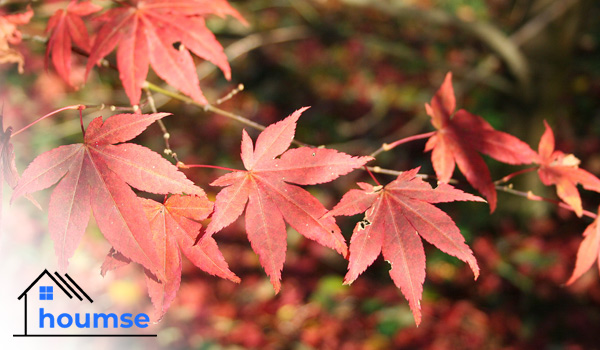
This Japanese red maple is by far one of the best-known and most loved varieties. It has the same characteristics as the previous one. The only difference is that it looks more like a bush than a tree. Atropurpureum does not usually exceed 20 feet in height, and often branches from the ground. Its leaves are red during spring and fall but turn reddish-green in summer.
Acer palmatum ‘Oshio Beni’
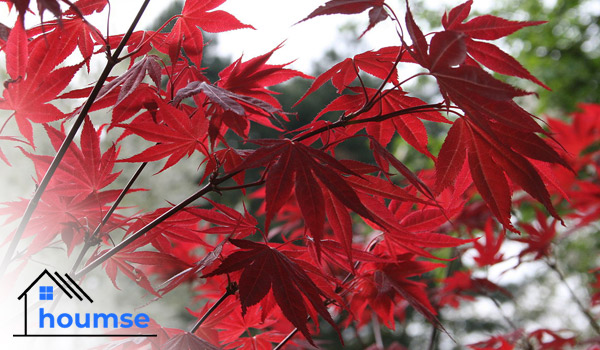
This dwarf Japanese maple is ideal for growing in small gardens, as it reaches between 10-16 inches. Its trunk branches from almost ground level, which provides that oriental touch that many admire. Oshio Beni is also perfect for a Japanese red maple tree enthusiast since it resembles ‘Atropurpureum’ closely but displays a brighter red color.
Red Dragon Japanese Maple
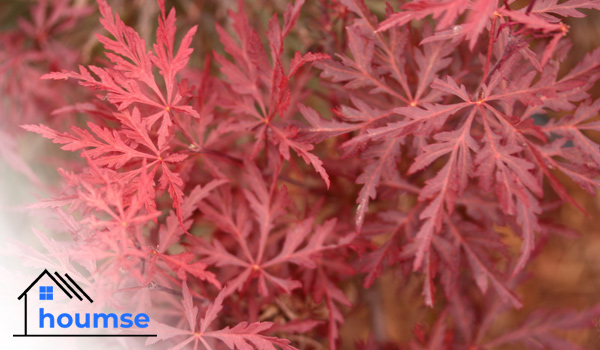
As a small cultivar, the red dragon Japanese maple tree boasts reddish-purple foliage that turns into bright deep red in the fall. This tree has an upright growth habit, which makes it a plant for both landscapes and containers.
Acer palmatum ‘Orange Dream’

Among Japanese maple varieties, the ‘Orange Dream’ variety is a true beauty. It grows to a maximum height of 10 feet, so you can consider it to decorate the patio or terrace. Additionally, it is eye-catching all year round: in spring its leaves are red and then yellow, in summer they are green, and during autumn they take on a spectacular orange color.
Acer palmatum ‘Seiryu’

The ‘Seiryu’ is simply marvelous. It grows to a height of 16-26 feet, either with a tree-like trunk or branched from the base. This one is a little different from other types of Japanese maples so far, as the lobes of its leaves are much thinner, and have a jagged edge, which gives the plant a feathery appearance. In spring and summer, they are green. And in fall, they take on an incredibly intense red.
Acer palmatum ‘Shigitatsu-sawa’
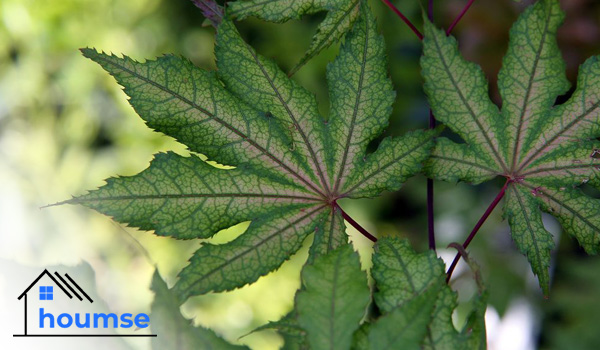
Although not well known yet, this is one of the most recommended varieties if you are looking for one that, in addition to being beautiful, provides good shade. It can grow to a height of 25 feet. A Shigitatsu-sawa Japanese maple leaf is palmate, greenish-yellow in spring and summer, and strikingly reddish-orange in fall.
Acer palmatum ‘Beni Maiko’
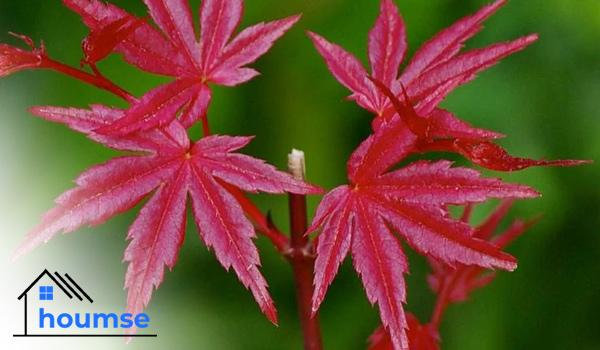
Acer palmatum ‘Beni Maiko’ is a popular cultivar for those who prefer Japanese red maple trees over green Japanese maple. When mature, it looks like a red maple (Acer rubrum) but with a brighter red color. Being grafted, you can make sure that its height will not exceed 16 feet (5m). The leaves are quite reminiscent of those of Acer palmatum ‘Atropurpureum’, although they are slightly smaller, at least when young.
Bloodgood Japanese Maple Tree
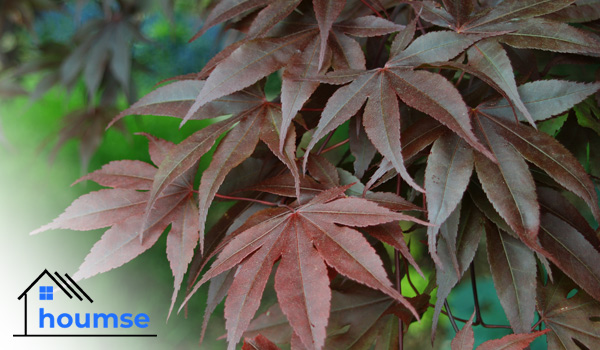
The Bloodgood Japanese maple tree is a precious cultivar very similar to the ‘Atropurpureum’. However, it does not grow as tall (about 13-16 feet). Its leaves turn a much more intense purple-red color as well. Interestingly, the Bloodgood Japanese maple tree does not stop being red during the summer.
This species is a good choice for areas that have a warm Mediterranean climate, with mild autumns and winters with very light frosts.
Acer palmatum ‘Deshojo’
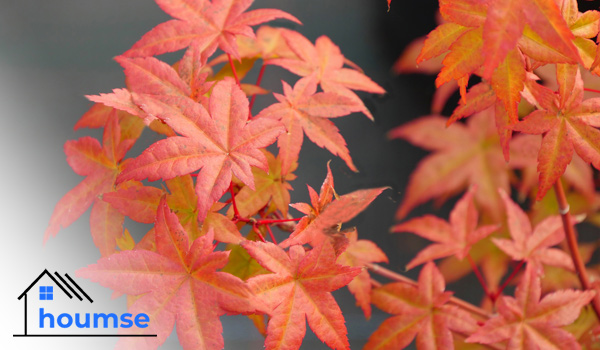
The ‘Deshojo’ variety reaches a height of 20-23 feet with a fairly fast growth rate (about 8 inches per year in ideal conditions). Like the typical Acer palmatum, this is also a green Japanese maple for most of the year. But, during the fall, it will turn into a charming and bright Japanese red maple tree with soft leaves.
Acer palmatum ‘Osakazuki’
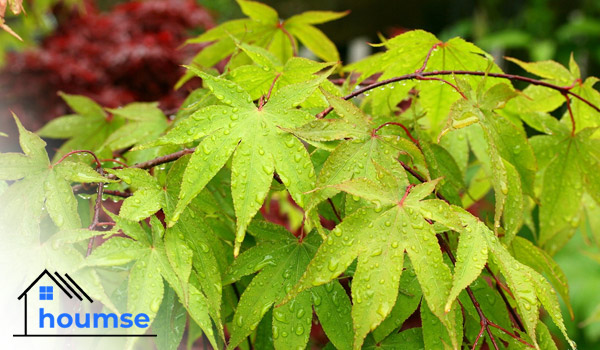
The ‘Osakazuki’ grows almost as tall as the ‘Deshojo’ in height. It features palmate leaves that turn red during the fall. Like the ‘Seiryu’, it can tolerate a couple of hours of direct sunlight, even if it is grown in areas where the temperature exceeds 80ºF during the summer.
Acer palmatum ‘Senkaki’ (Sango Kaku)
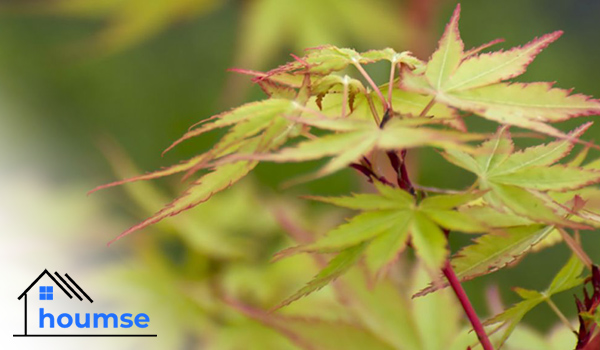
The ‘Senkaki’ or ‘Sango Kaku’ is one of the most ornamental types of Japanese maples. Its branches have an intense red color, which is why it is known as Coral Bark Maple in English. This green dwarf Japanese maple grows about it reaches a height of 13-16 feet displaying palmate leaves that turn yellow-pink in the fall.
Acer japonicum ‘Aconitifolium’

The ‘Aconitifolium’ is one of the compact types of Japanese maples growing up to 15 feet featuring leaves very similar to ‘Seyriu’ with slightly wider lobes. This plant looks great in any corner and you will be able to enjoy it all year round, especially in autumn when its leaves take on a spectacular bright red.
Acer japonicum ‘Vitifolium’
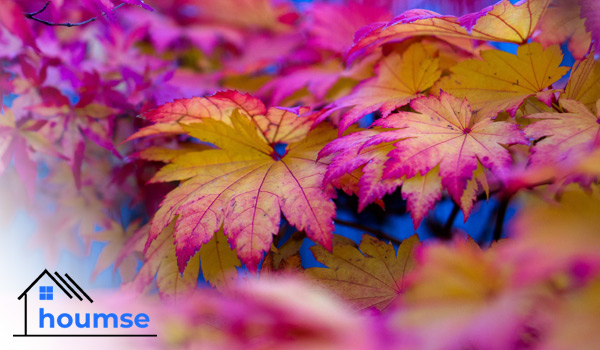
A ‘Vitifolium’ Japanese maple leaf is palmate and large, up to 6 inches wide and 3 inches high. This delightful variety reaches 23 feet in height and dresses in a red-orange color during the fall.
Other Japanese Maple Varieties
- Butterfly, that has leaves with white edges.
- Little Princess, which is small in size and does not exceed 7 feet.
- Katsura, which features yellow and green foliage, with orange markings.
Japanese Maple Care
The Japanese maple is an ideal plant to have in pots or gardens if you know how to care for it. Since Japanese red maple tree care differs in each situation, let us review its requirements separately:
Japanese Maple Care in Pots
Interested in growing a dwarf Japanese maple or perhaps a large variety in a container, consider these tips:
Soil
To grow this plan successfully in a pot, provide a potting mix with good drainage, but which also has a low 4-6 pH. If you live in a climate warm, we recommend mixing 70% akadama with 30% kiryuzuna so the roots are properly aerated. This way, they can quickly carry water to the leaves, preventing them from drying out.
Water
Watering a Japanese red maple should be frequent since it does not resist drought. It is better to use acidic water (you can acidify it by diluting half a lemon’s juice in 1 liter of water), or rainwater, at least 3-4 times a week. Increase irrigation sessions in summer.
Light
Place your maple in a place without direct sunlight. Although, as mentioned, there are some cultivars, like Seiryu or Osakazuki, that can tolerate a few hours of direct sunlight. But it is better not to risk it. Locate them in a very bright area but always away from direct sunlight that can burn the beautiful Japanese maple leaf.
Potting and Re-potting
A potted tree should be repotted every 2 years, especially if using a very porous growing medium or living in a suitable climate. Re-pot towards the end of winter, so the frost does not damage the plant, in a pot at least 2 inches wider.
Fertilizer
Feed the plant with specific fertilizers for acid-lover plants, following the recommendations on the package (normally it is once a week). To achieve a more vigorous, healthier plant, some recommend fertilizing every other month with liquid organic fertilizers, such as guano, which has a rapid effect.
Note: You may apply the same instructions when growing types of Japanese maples in the garden.
Japanese Maple Care in Gardens
When growing in gardens, these are the main requirements of these species:
Soil
The soil should have a pH between 4 and 6. In gardens, Japanese maple trees could also thrive in limestone soils to which pine needles and/or iron sulfate are added regularly to keep the pH suitable levels.
Water
The watering will have to be regular, between 2 and 3 times a week; up to 4 during the warmer months of the year.
Light
As established, these varieties do not like direct sun. So, it is convenient to locate them where there are tall plants or a wall to protect them from the harsh sun.
Transplant
Transplant during the spring, before the Japanese maple leaf buds. To do this, make a hole big enough to fit well, place your maple, and fill the hole with soil for acid-loving plants. If the soil you have has a pH between 4 and 6, you can use the soil you dug before.
When & How to Prune a Japanese Maple Tree
Pruning allows you to have a Japanese or even a Chinese maple tree with a smaller, more compact size. Some cultivars can grow quite a bit, perhaps more than one expects and/or wishes. In these cases, it is advisable to prune it.
The most recommended time for pruning these varieties is in autumn or toward the end of winter when the tree is not yet fully awake and active. Once you decide the day for pruning, take a hand saw, prune the shears, and remove or trim those branches that intersect, are too long, or look weak or sickly.
Japanese Red Maple Tree Pests and Diseases
This plant, although it may seem otherwise, is not usually affected by pests or diseases. Cotton mealybugs, red spiders, aphids, and fungi are among the common problems. To avoid these problems:
- Do not let the soil be soggy and waterlogged.
- Avoid growing this species in humid environments.
- Use ecological insecticides, such as nettle slurry or Neem oil available at nurseries, or home remedies using garlic cloves.
And in order to treat them:
- Choose an insecticide and/or fungicide. If mealybugs or other pests are the problem, eliminate them with Chlorpyrifos or Imidacloprid.
- In the case of fungi, in addition to reducing the frequency of watering, treat the plant using a broad-spectrum fungicide.
Green Japanese Maple Propagation
Do you aspire to have your own Japanese maple? You can do this using different methods:
Propagation by Seeds
Japanese maple seeds should be collected in the fall and stored in the refrigerator for 3 months, at a temperature of 42-44ºF so they can germinate.
So, once you have the seeds, plant them in a transparent container with vermiculite, and cover them with a thin layer of vermiculite. Slightly water and add a pinch of sulfur to prevent fungi. At least once a week, take the container out and open it to freshen the air.
After 3 months, you can plant the Japanese maple seeds in pots with soil for acidic plants, placing them in a location sheltered from direct sun. If all goes well, they will germinate in a month or two.
Propagation by Cuttings
Japanese maple propagation using cutting is one of the fastest and most effective methods. To have a cutting, select a branch that is at least 1 inch thick and 15-20 inches long, and prune it around the beginning of spring.
Next, moisten the base, dip it in rooting hormones, and plant it in a pot with a well-draining potting mix. Keep the soil slightly moist and the cutting will begin rotting within 5-6 months.
Propagation by Air Layering
To avoid any risk, we recommend this method. To do this, you must remove a piece of bark (about 4 inches), moisten it with water and apply rooting hormones to it. Then, tie one end of a plastic bag to the branch, fill it with suitable soil for acid plants, moisten it, and tie the other end. Keep the soil moist (use a syringe 3-4 times a week) and over 4-6 months it will root.
Propagation by Grafting
Japanese maple tree grafting is mostly used by experts to obtain new and more wonderful cultivars.
The Bottom Line
Different types of Japanese maple can be used in different settings, due to the species' versatile and resilient nature. They can be used in large gardens or in pots; and regardless of their location, they require dedicated care and regular pruning to thrive. You can grow your own Japanese maple, as there are multiple effective methods for propagating them.
- In this post:
- Japanese Maple Characteristics
- Types Of Japanese Maples (Cultivars)
- Japanese Maple Care
- When & How to Prune a Japanese Maple Tree
- Japanese Red Maple Tree Pests and Diseases
- Green Japanese Maple Propagation
- The Bottom Line



